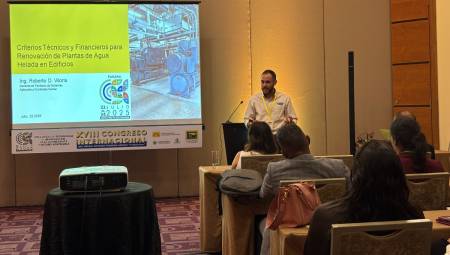Article submitted by Nelson Troconis P
As for the claims of the national government to join the use of nuclear energy as an energy source, under the auspices of the Russian government, as an ecologist I leave some documented impressions about the inconvenience of it, whose starting point is the discovery of the uranium atom by the scientist Alberto Einstein (1939). After this discovery, the atomic bombs detonated in the cities of Japan, Hiroshima and Nagasaki (1945-46) were built. From these events, an intense and competitive war-nuclear race was unleashed, which is under the control and monopoly of the great powers of the world.
The average life span of a nuclear reactor is 40 years, then it becomes highly hazardous waste given the impossibility of bringing radioactive material to a state of safety. The main radioactive substances include Barium-140, Cesium-134 and 137, Cobalt-60, Strontium-90, Phosphorus-32, Yttrium-90, Krypton-85, Molybdenum-99 Polonium-210, Iodine-131, Plutonium-239 and Radium-224 and 226, the latter two have a half-life between 24,500 and 1,620 years respectively.
There are extensive references to the threat posed to humanity and the environment in general, the use of nuclear energy, whatever its use (military or civil) warning about the danger, under the pretext of becoming reliable energy sources; on the contrary, this type of energy represents a real risk for humanity since nuclear energy is neither cheap, nor clean nor safe. The three hundred nuclear reactors currently in operation in the world and the hundreds of reactors already planned, have become a serious threat to life on the planet.
The most dramatic damages are recorded by accidents that occurred in nuclear plants or power plants -both in the Soviet Union- such as that of Mayak, in the Ural Mountains (1957) justified in the existence of providing Russia with the plutonium necessary for the "atomic bomb", in which the spent nuclear fuel in the reactors was processed, extracting uranium, plutonium and neptune, elements needed to produce a new nuclear fuel called MOX.
On September 29, 1957 a failure of the cooling system, exploded a tank, which released a radioactive force equivalent to 80 tons of TNT, scattered in a radius of 23,000 Km2, affecting about 272,000 people directly, then because of the winds, the radius of action expanded, totaling to 437,000 the number of people.
The measurement of this environmental catastrophe is summarized as follows: more than 8,000 people died from the pollution of the Techa River; half of the inhabitants of the area are sterile; 30 per cent of children are born with physical and mental dysfunctions and birth defects; a high percentage of people have serious heart, digestive, circulatory, bone and joint problems; almost every week someone dies of leukemia (blood cancer), as have other types of cancer along with other vascular diseases; the life expectancy or average life span for women and men ranges from 45 to 47 years respectively.
As for the Chernobyl accident, recognized until today as the greatest nuclear catastrophe, when one of its reactors exploded, with a record of damage even in very distant areas: In 1992 in ice caps in Greenland, radioactive dust was located, the same in Sweden; radioactivity destroyed much of the Lappish habitat and caused serious damage to the dairy farm area of central Lappish; in the city of Kiev, 40 km from Chernobyl, more than half a million people affected by radioactivity are monitored for health problems; in Ukraine, chromosomal diseases have been detected among its inhabitants since 1989; exposure to radioactivity of the parents caused leukemia in their offspring; more than six thousand people are reported to have died from thyroid cancer. By 2006 this long chain of damages registered 270,000 cases of cancer, with a high mortality.
Next, a collection and recording of events, tests and nuclear accidents, which have caused radioactive contamination (1945-1993) are collected and recorded, such as the following:
The United States detonates its first nuclear bombs in Hiroshima and Nagasaki (1945-46).
-The United States (Marshall Islands) and the Soviet Union (Kazakhstan) begin their nuclear tests, where very high amounts of iodine escaped into the atmosphere (1949).
In the Marshall Islands, a 15-megaton thermonuclear bomb detonated (1954).
- Britain tests its first nuclear bomb in the Cristmas Islands (1957).
-In the Ural Mountains of Russia, a radioactive waste storage tank explodes.
An American plane accidentally drops two nuclear bombs.
Two American B-47 bombers suffer accidents carrying nuclear bombs (1958).
-A nuclear reactor in Yugoslavia suffers an accident killing several people because of the accident.
-At a research center in Alamos in North America, several workers die from the leak of plutonium.
-An atomic reactor is lost in the Atlantic Ocean (1959).
France begins its atomic career with nuclear tests in the Sahara Desert (1960).
-An American satellite suffers an accident and leaks plutonium which affects the atmosphere in more than twelve countries (1963).
-Between 1964-67 there have been more than ten nuclear accidents in various parts of the world, generating pollution in the air and water.
France conducts its first experiment with "H" bombs on the Pacific Ocean Atolls (1969).
-In the atomic test center of Nevada, cracks appear in the earth and a nuclear fungus arises that rises to 3 km high and affects numerous personnel working in the place (1970).
- A Soviet nuclear submarine suffers an accident that releases radioactive substances (1972).
-It is estimated that the Hanford nuclear complex has dumped 1,600 million radioactive material (1974).
Hundreds of Soviet soldiers die while tracking a highly polluted area on Lake Baikal (1975).
-In a nuclear test in the State of Nevada where about 170,000 soldiers participate, most of them registered cases of leukemia.
-A truck loaded with plutonium has an accident and spills on the Colorado highway 20,000 tons of this radioactive element (1977).
-The Cosmos satellite carrying a nuclear reactor crashes into a lake in Canada (1978).
-An atomic equipment belonging to the CIA located on Mount Himalayas produced strong contamination to the Ganges River.
In San Diego Bay, a nuclear aircraft carrier spills 50 liters of highly radioactive water (1979).
-France continues with its nuclear tests in the atoll of Mururoa, in these exercises several workers die and plutonium is spread in the place.
-The Tsurunga nuclear plant in Japan discharges polluting waste directly into the sea (1981).
- An atomic submarine sinks near the Kamchatka Peninsula (1983).
-In Dakota, the cargo of uranium carried by a truck is spilled (1985).
-Reactor No. 4 of the Chernobyl nuclear plant explodes, whose contamination extends throughout Europe (1986).
-A radioactive leak occurs in facilities located in Darmstadt, West Germany (1987).
- A Japanese atomic reactor leaks radioactive material (1988).
North Wales, Spain, a ship carrying radioactive material sinks.
-There are three nuclear accidents in Japan known as Fululk, Onagwa and Kashiwazaki (1991).
Escape at a nuclear weapons stockpile in North Dakota.
-Three radioactive leaks are detected at the Kozloduj nuclear power plant in Bulgaria.
-There is an accident in the nuclear accelerator of a hospital in Zaragoza in Spain, affecting groups of people by the fumes.
-Russia dumps radioactive waste in the Kara Sea (1992).
-Nuclear accident at the Sosnovi Bor plant, near St. Petersburg, where its effects have repercussions even in Sweden.
-Nuclear leaks at the Kozloduj (Bulgaria) and Ignalina (Lithuania) power plants.
In the Philippine Islands in 1991, toxic waste emanating from a U.S. military base causes multiple diseases to workers and children.
-France persists with its nuclear tests in the muroroa atoll, continuing with the generation of contamination of radioactive material (1993).
This nonsense of the Venezuelan regime must have other implications (hidden agenda) since it is illogical that the country with secure sources and proven reserves of oil and gas, in case of pretensions of energy diversification, should opt for clean sources, such as wind, water or solar and never for nuclear, turned into a kind of messenger of death.
Sources consulted:
Frijol Capra, The Crucial Point (1982).
Ana Fernandez. How to survive the twenty-first century (2000)
NelsonTroconis.P Environmental Protection (2005)
–Peace, Environment and Development as Human Rights (2007)
Related Posts:
- Environmental Impact of Wind Energy
- Environmental Impact and Environmental Policies
- Environmental Impact of Divorce
- Environmental Impact Of The Disappearance Of Light And Force, What We Expect From CFE
- Environmental and Nuclear Energy Legislation and Radioactive Waste of Mexico













